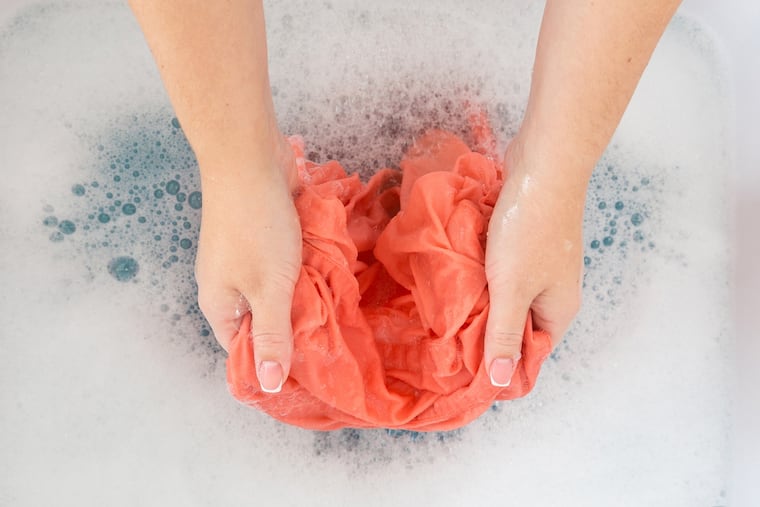Dirty little secrets of doing hand laundry on the road
Too cheap to send out my laundry, too time-strapped to sit in a self-service laundry, I resorted to the sink, cool water, and a Tide detergent pod. My loathing of laundry was exceeded only by the self-loathing of being bad at it.

I did something on a recent two-week trip that I promised I would never do again. In the wee hours of the morning, I was hunched over the bathroom sink, just me, my blouse, my jeans, and a pair of socks.
I wasn’t wearing them; I was washing them.
Too cheap to send out my laundry, too time-strapped to sit in a self-service laundry, I resorted to the sink, cool water, and a Tide detergent pod. My loathing of laundry was exceeded only by the self-loathing of being bad at it.
But with education — textile experts, veteran travelers, and one product developer — I am a changed woman. Or at least a woman who will have a clean change of clothes.
Here’s what I learned:
Consider the fabrics. If you’re a serious traveler, no more buying clothes for your trip just because they look smart. Leave the linen in your closet. Silks? They should probably stay home if you don’t want to look like a rumpled mess.
“Fabrics, broadly, for apparel come in two basic fabric constructions — knit fabrics or woven fabrics,” said Janet Brady, an associate professor of textiles at Thomas Jefferson University – what used to known as Philadelphia Textile — in Philadelphia.
The fibers in a knit are interlooped; woven fabrics are made of two sets of yarns that intersect at right angles, she said. Or, more simply, an undershirt is a knit; an oxford cloth shirt is a woven.
"Knits usually have stretch in both directions and have a little more give in both directions," Brady said.
Which means they tend to regain their shape, which makes them a little more travel-friendly.
Don’t be a purist. By "purist," we mean insisting on clothing that is 100% one fiber.
That may be why my cotton jeans fell in the "loser" category. Days 11, 12, and 13 of my 14-day trip were in a place so humid that my stick-straight hair began to curl. Worse, my jeans, soaked with perspiration after a vigorous outing, had stretched so much I could have fit a large wheel of cheese in my pants when I donned them the next day.
I’m not advocating a return to polyester pants, which are like walking around in a trash bag if you remember the ’60s, but a little bit of Lycra blended with that cotton might have rendered a sudsing unnecessary, said Mary Ankeny, vice president of product development and implementation operations for Cotton Inc., the nonprofit research and marketing arm of the U.S. cotton industry.
One pair of slacks did regain their shape after a cool-down -- the label said they contained some stretchy fibers -- and a light dusting of baby powder inside the legs helped freshen them.
How dry they’re not. Here’s a no-duh newsflash: If it’s so humid that there’s a thunderstorm every afternoon, your jeans are A) not going to dry, and B) ought to be stuffed in a plastic bag for the trip home. Opening the suitcase with that kettle of fish was particularly delightful.
I had washed a different pair of jeans in the sink on Day 7, and they came out just fine, thanks to a drier climate and my new BFF: the heated towel rack, which became a stand-in for a dryer. Unfortunately, the next hotel didn’t have one of these little beauties.
No wringing clothes. A squeezing action is better, the fabric specialists said, followed by rolling in a towel.
That’s often a better solution than dunking an entire garment, Ankeny said. If you have a spot of something on your shirt or blouse, try the shampoo or body wash -- test first in an inconspicuous place -- that’s usually provided by your hotel, Ankeny said.
Those products will work fine for sink washing, too, the fabric experts said. My detergent pod might have been too strong for a not-very-large basin, and I am certain I failed to rinse vigorously enough, which can leave clothes dingy at best and dirt magnets at worst.
The ironing room. I don’t like to iron, either, but I do love the outcome. So an oxford-cloth blouse — folded nicely in my packing cube — wasn’t in terrible shape (but it would have been nicer if I had rolled it, Ankeny said), but I wanted to crisp the edges, so to speak.
Problem: None of my European rooms had an iron or board. Solution: Ask whether there’s an ironing room, Ankeny said. Who knew?
Failing that, a spritz of water from a bottle and a smoothing action may do the trick.
Post-trip, I tried Tom and Sheri’s Iron in a Bottle wrinkle remover, which worked so well I wished there were a version for my face. It comes in a 3-ounce bottle.